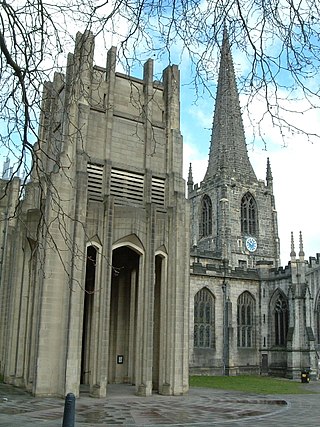
The Cathedral Church of St Peter and St Paul, Sheffield, also known as Sheffield Cathedral, is the cathedral church for the Church of England diocese of Sheffield, England. Originally a parish church, it was elevated to cathedral status when the diocese was created in 1914. Sheffield Cathedral is one of five Grade I listed buildings in the city, along with the Town Hall, Abbeydale Industrial Hamlet, and the parish churches at Ecclesfield and Bradfield.

St Giles' Cathedral, or the High Kirk of Edinburgh, is a parish church of the Church of Scotland in the Old Town of Edinburgh. The current building was begun in the 14th century and extended until the early 16th century; significant alterations were undertaken in the 19th and 20th centuries, including the addition of the Thistle Chapel. St Giles' is closely associated with many events and figures in Scottish history, including John Knox, who served as the church's minister after the Scottish Reformation.

Holy Sepulchre London, formerly and in some official uses Saint Sepulchre-without-Newgate, is the largest Anglican parish church in the City of London. It stands on the north side of Holborn Viaduct across a crossroads from the Old Bailey, and its parish takes in Smithfield Market. During medieval times, the site lay outside ("without") the city wall, west of the Newgate.

The Cathedral-Basilica of Saint Louis, King of France, also called St. Louis Cathedral, is a Catholic cathedral and basilica in New Orleans, Louisiana. It is the seat of the Archdiocese of New Orleans and is the oldest cathedral in continuous use in the United States alongside the Royal Presidio Chapel in Monterey, California. It is dedicated to Saint Louis, also known as King Louis IX of France. The first church on the site was built in 1718; the third, under the Spanish rule, built in 1789, was raised to cathedral rank in 1793. The second St. Louis Cathedral was burned during the great fire of 1788 and was expanded and largely rebuilt and completed in the 1850s, with little of the 1789 structure remaining.
This timeline of Sheffield history summarises key events in the history of Sheffield, a city in England. The origins of the city can be traced back to the founding of a settlement in a clearing beside the River Sheaf in the second half of the 1st millennium AD. The area had seen human occupation since at least the last ice age, but significant growth in the settlements that are now incorporated into the city did not occur until the Industrial Revolution.

The Parish Church of St Margaret is a Church of England parish church situated on St Margaret's Road, off Bury Old Road (A665) in Prestwich, Greater Manchester, England. The Grade II listed church, in the Diocese of Manchester, was designed in the Decorated style by the Manchester architects Travis and Mangnall in 1849 as a chapel-of-ease to the ancient Prestwich Parish Church of St Mary the Virgin. Opened in 1851, it was extended in 1863, 1871, 1884, 1888 and 1899, and is notable for its fine Arts and Crafts wood carvings by Arthur Simpson of Kendal and late twentieth-century fittings. The church's daughter church of St George, Simister, is in the same parish.

The Cathedral Church of St Mary and St Thomas is a Roman Catholic cathedral in Northampton, England. It is the seat of the Bishop of Northampton and mother church of the Diocese of Northampton which covers the counties of Northamptonshire, Bedfordshire, Buckinghamshire and part of Berkshire north of the River Thames. The cathedral is situated in the north of the town, along the Barrack Road.

St Peter's Church is a church in Brighton in the English city of Brighton and Hove. It is near the centre of the city, on an island between two major roads, the A23 London Road and A270 Lewes Road. Built from 1824–28 to a design by Sir Charles Barry, it is arguably the finest example of the pre-Victorian Gothic Revival style. It is a Grade II* listed building. It was the parish church of Brighton from 1873 to 2007 and is sometimes unofficially referred to as "Brighton's cathedral".
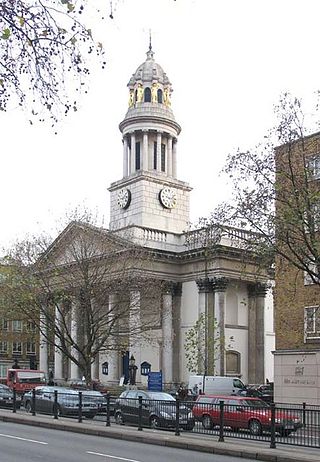
St Marylebone Parish Church is an Anglican church on the Marylebone Road in London. It was built to the designs of Thomas Hardwick in 1813–17. The present site is the third used by the parish for its church. The first was further south, near Oxford Street. The church there was demolished in 1400 and a new one erected further north. This was completely rebuilt in 1740–42, and converted into a chapel-of-ease when Hardwick's church was constructed. The Marylebone area takes its name from the church. Located behind the church is St Marylebone School, a Church of England school for girls.

Leeds Minster, also known as the Minster and Parish Church of Saint Peter-at-Leeds is the minster church of Leeds, West Yorkshire, England. It stands on the site of the oldest church in the city and is of architectural and liturgical significance. A church is recorded on the site as early as the 7th century, although the present structure is a Gothic Revival one, designed by Robert Dennis Chantrell and completed in 1841. It is dedicated to Saint Peter and was the Parish Church of Leeds before receiving the honorific title of "Minster" in 2012. It has been designated a Grade I listed building by Historic England.

The Parish Church of St Cuthbert is a parish church of the Church of Scotland in central Edinburgh. Probably founded in the 7th century, the church once covered an extensive parish around the burgh of Edinburgh. The church's current building was designed by Hippolyte Blanc and completed in 1894.
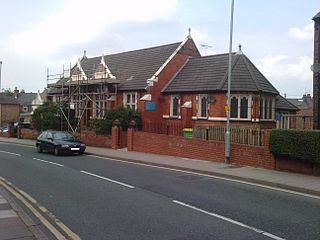
The Church of St. Thomas of Canterbury is an active Anglican parish church situated in the City of Chester, in an area of the city informally known as "The Garden Quarter", a densely populated area, close to the University. The church was built in 1872, but the parish of St. Oswald which it serves is much older, dating back to about 980 AD. One of the earliest references to St. Oswald's can be found in Bradshaw's. The parish registers date back to 1580. The church is recorded in the National Heritage List for England as a designated Grade II listed building. The church is part of the diocese of Chester, the archdeaconry of Chester and the deanery of Chester. The patrons of the parish are the dean and chapter of Chester Cathedral.
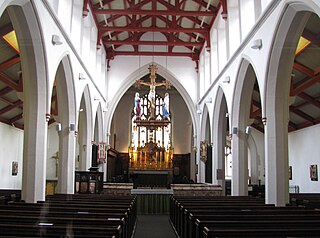
St Matthew's Church, more usually known as St Matthew's Carver Street, is situated on Carver Street in the centre of Sheffield, South Yorkshire, England. It is a Grade II listed building located at grid reference SK351871. The church is part of the Anglo-Catholic movement.

St Cyprian's Church, Hay Mills is a parish church of the Church of England in Hay Mills, Birmingham, England. It is situated on the southern side of the main Birmingham to Coventry Road A45 at the end of a lane called the Fordrough that leads to the factory of Webster & Horsfall Ltd. It has long been associated with the Horsfall family who built the church and continue to be its owners. Built in the 19th century of red brick in the Gothic Revival style it is dedicated to St Cyprian the third century martyr and Bishop of Carthage who although coming from a wealthy background gave away a portion of his wealth to the poor of Carthage, he was beheaded by the Romans in 258. The church is now Grade II listed.

St Mary's Church, Moseley is a Grade II listed parish church in the Church of England located in Moseley, Birmingham. It is now part of a united benefice with St Anne's Church, Moseley. The War Memorial in the South-East corner of the Churchyard, facing Oxford Road, is unusual in that it depicts Christ upon the cross in carved stone. The War Memorial has achieved its own Grade II listing.

Underbank Chapel is a Unitarian place of worship in Stannington, a suburb of Sheffield, South Yorkshire. It is a member of the General Assembly of Unitarian and Free Christian Churches, the umbrella organisation for British Unitarians.

St Margaret's, Putney is situated in Putney Park Lane, Putney, London, England. It was designed by W. Allen Dixon in 1872. Prior to its dedication to St Margaret as an Anglican church it was first a Baptist and then a Presbyterian chapel under the name of Granard Chapel. It is part of the Wandsworth Deanery in the Southwark Diocese of the Church of England, and is also a member of Churches Together in Putney and Roehampton. It is a member of Inclusive Church and during Winter months it runs a homeless shelter once a week with Glass Door. The vicar is currently (2020) the Revd Dr Brutus Green.
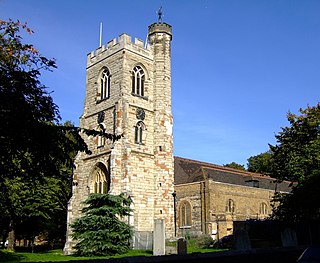
All Saints Church is a parish church in West Ham, an area in east London. It has been a Grade I listed building since 1984.
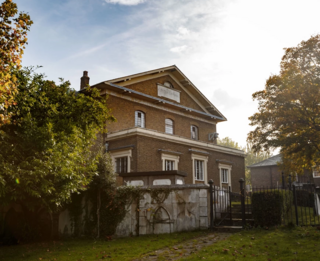
St Paul's Church is a Church of England parish church in Clapham, London. There has been a church on the site since the 12th century. The current building was completed in 1815 and is Grade II* listed. In the grounds, which hold the Green Flag Award, are some fine tombs including many early 19th century sarcophagi and a community garden, Eden. The incumbent is Revd Canon Jonathan Boardman.

St Andrew's Orthodox Church is an Orthodox church located in the Southside, Edinburgh, Scotland. Edinburgh's Orthodox community was founded in 1948 and has, since 2013, occupied the former Buccleuch Parish Church, which was founded as a chapel of ease of St Cuthbert's in 1756 and closed in 1969.





















